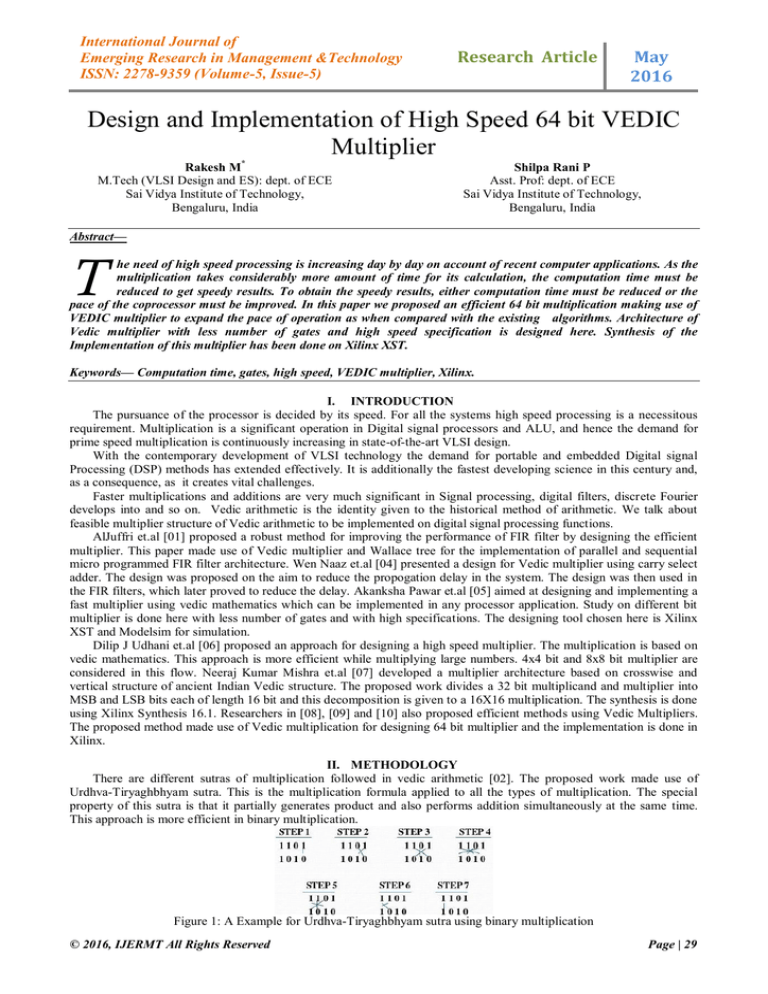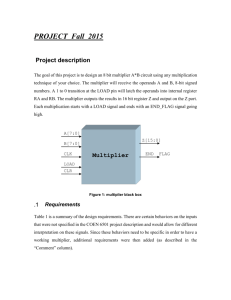
International Journal of
Emerging Research in Management &Technology
ISSN: 2278-9359 (Volume-5, Issue-5)
Research Article
May
2016
Design and Implementation of High Speed 64 bit VEDIC
Multiplier
Rakesh M*
M.Tech (VLSI Design and ES): dept. of ECE
Sai Vidya Institute of Technology,
Bengaluru, India
Shilpa Rani P
Asst. Prof: dept. of ECE
Sai Vidya Institute of Technology,
Bengaluru, India
Abstract—
T
he need of high speed processing is increasing day by day on account of recent computer applications. As the
multiplication takes considerably more amount of time for its calculation, the computation time must be
reduced to get speedy results. To obtain the speedy results, either computation time must be reduced or the
pace of the coprocessor must be improved. In this paper we proposed an efficient 64 bit multiplication making use of
VEDIC multiplier to expand the pace of operation as when compared with the existing algorithms. Architecture of
Vedic multiplier with less number of gates and high speed specification is designed here. Synthesis of the
Implementation of this multiplier has been done on Xilinx XST.
Keywords— Computation time, gates, high speed, VEDIC multiplier, Xilinx.
I. INTRODUCTION
The pursuance of the processor is decided by its speed. For all the systems high speed processing is a necessitous
requirement. Multiplication is a significant operation in Digital signal processors and ALU, and hence the demand for
prime speed multiplication is continuously increasing in state-of-the-art VLSI design.
With the contemporary development of VLSI technology the demand for portable and embedded Digital signal
Processing (DSP) methods has extended effectively. It is additionally the fastest developing science in this century and,
as a consequence, as it creates vital challenges.
Faster multiplications and additions are very much significant in Signal processing, digital filters, discrete Fourier
develops into and so on. Vedic arithmetic is the identity given to the historical method of arithmetic. We talk about
feasible multiplier structure of Vedic arithmetic to be implemented on digital signal processing functions.
AlJuffri et.al [01] proposed a robust method for improving the performance of FIR filter by designing the efficient
multiplier. This paper made use of Vedic multiplier and Wallace tree for the implementation of parallel and sequential
micro programmed FIR filter architecture. Wen Naaz et.al [04] presented a design for Vedic multiplier using carry select
adder. The design was proposed on the aim to reduce the propogation delay in the system. The design was then used in
the FIR filters, which later proved to reduce the delay. Akanksha Pawar et.al [05] aimed at designing and implementing a
fast multiplier using vedic mathematics which can be implemented in any processor application. Study on different bit
multiplier is done here with less number of gates and with high specifications. The designing tool chosen here is Xilinx
XST and Modelsim for simulation.
Dilip J Udhani et.al [06] proposed an approach for designing a high speed multiplier. The multiplication is based on
vedic mathematics. This approach is more efficient while multiplying large numbers. 4x4 bit and 8x8 bit multiplier are
considered in this flow. Neeraj Kumar Mishra et.al [07] developed a multiplier architecture based on crosswise and
vertical structure of ancient Indian Vedic structure. The proposed work divides a 32 bit multiplicand and multiplier into
MSB and LSB bits each of length 16 bit and this decomposition is given to a 16X16 multiplication. The synthesis is done
using Xilinx Synthesis 16.1. Researchers in [08], [09] and [10] also proposed efficient methods using Vedic Multipliers.
The proposed method made use of Vedic multiplication for designing 64 bit multiplier and the implementation is done in
Xilinx.
II. METHODOLOGY
There are different sutras of multiplication followed in vedic arithmetic [02]. The proposed work made use of
Urdhva-Tiryaghbhyam sutra. This is the multiplication formula applied to all the types of multiplication. The special
property of this sutra is that it partially generates product and also performs addition simultaneously at the same time.
This approach is more efficient in binary multiplication.
Figure 1: A Example for Urdhva-Tiryaghbhyam sutra using binary multiplication
© 2016, IJERMT All Rights Reserved
Page | 29
Rakesh et al., International Journal of Emerging Research in Management &Technology
ISSN: 2278-9359 (Volume-5, Issue-5)
In this multiplication approach, the inputs are divides into LSBs and MSBs, these two forms a combination of four
and these four combinations are multiplied and added. As shown in the design, the carry generated from one adder is
utilized in the other as per the flow. The carry out from the adders must not be neglected and must be added at a
particular bit value. This leads to the generation of the bits of the carry and the result. The architecture of the proposed
system is as shown in the Figure 2. The given architecture implements 64 bit Vedic multiplier using 32 bit multiplier
using carry save adder [03]. Which use the structural programming style and implemented using Verilog HDL. The
output of the 32 bit multiplier will go through 64 bit adder module to give the final product of 128 bits.
Figure 2: Block Diagram of the 64X64 bit Vedic Multiplication
III. EXPERIMENTAL RESULTS
The proposed 64 bit Vedic Multiplier is coded using Xilinx ISE Design Suite 13.2 and simulated using ISim
(0.61xd) simulator. The simulated experimental result is shown in the figure below.
Case 1:Input A = 1234123412341234
Input B = 1234123412341234
Output S = 014B5D26B90214DD6E221246B66B5A90
Figure 3: Simulation Result-1
Case 2:Input A = 1355732153214984
Input B = 6574516874352146
Output S = 07A97F4A3DD0D94CEE5EB3A80DE81E18
Figure 4: Simulation Result-2
Case 3:Input A = FFFFFFFFFFFFFFFF
Input B = FFFFFFFFFFFFFFFF
Output S = FFFFFFFFFFFFFFFE0000000000000001
Carry out = 1
Figure 5: Simulation Result-3
© 2016, IJERMT All Rights Reserved
Page | 30
Rakesh et al., International Journal of Emerging Research in Management &Technology
ISSN: 2278-9359 (Volume-5, Issue-5)
IV. CONCLUSION
This paper presents a novel way of realizing high speed multiplier using Urdhva-Tiryagbhyam sutra and carry save
addition technique. A 32 bit modified multiplier is designed. The 64 bit multiplier is realized using four 32 bit Vedic
multipliers and two modified carry save adder. Vedic arithmetic deals with themes of arithmetic reminiscent of normal
mathematics. The proposed architecture proves to be incredibly fast and accurate.
REFERENCES
[1]
AlJuffri, A.A. King Abdulaziz, Riyadh, Saudi Arabia, Badawi, A.S and BenSaleh, M.S, “FPGA implementation
of scalable Micro Programmed FIR filter architectures using Wallace tree and Vedic multipliers”, Third IEEE
Conference on Electronics and Computer engineering, pp. 159 – 162, 2015.
[2]
Pramod P, Nisha.C.K, Saranya.M.K, Nithya.K and Chithra.S, “Design of Fast Multipliers using Vedic
Mathematics”, International Journal of Electrical, Electronics and Computer Systems (IJEECS), Vol. 3, Issue 2,
2015.
[3]
Sulakshna Thakur and Pardeep Kumar, “Area-Efficient & High Speed Ripple Carry based Vedic Multiplier”,
SSRG International Journal of Electronics and Communication Engineering, 2015.
[4]
Wen Naaz, S.A. Pradeep, M.N. Bhairannawar, S. Halvi, “FPGA Implementation of High Speed Vedic
Multiplier Using CSLA for Parallel Fir Architecture”, IEEE Conference on Devices, Circuits and Systems, pp.
1– 5, 2014.
[5]
Akanksha Pawar, Anil Kumar and Sahu Dr. G. R. Sinha, “Implementation of High Speed Vedic Multiplier”,
International Journal of Innovative Research in Advanced Engineering, Vol. 1, Issue 10, 2014.
[6]
Dilip J Udhani and R. C. Patel, “Implementation of High Speed Multiplier on FPGA” International Journal of
Science, Engineering and Technology Research (IJSETR), Vol. 3, Issue 2, 2014.
[7]
Neeraj Kumar Mishra and Subodh Wairya, “Low Power 32×32 bit Multiplier Architecture based on Vedic
Mathematics Using Virtex 7 Low Power Device”, International Journal of Research Review In Engineering
Science & Technology, Vol. 2, Issue 2, 2013.
[8]
Asmita Haveliya, “A Novel Design for High Speed Multiplier for Digital Signal Processing Applications”,
International Journal of Technology and Engineering System (IJTES), Vol. 2, Issue 1, 2011.
[9]
DR. Naresh and Dr. Giri Babu Kande, “High Speed Signed multiplier for Digital Signal Processing
Applications” IOSR Journal of Electrical and Electronics Engineering , Vol. 8, Issue 2, pp. 57-61.
[10]
Wen-Chang Yeh and Chein-Wei Jen, Member, IEEE, “High-Speed Booth Encoded Parallel Multiplier Design”,
IEEE Transactions on Computers, Vol. 49, Issue 7, 2000.
© 2016, IJERMT All Rights Reserved
Page | 31





